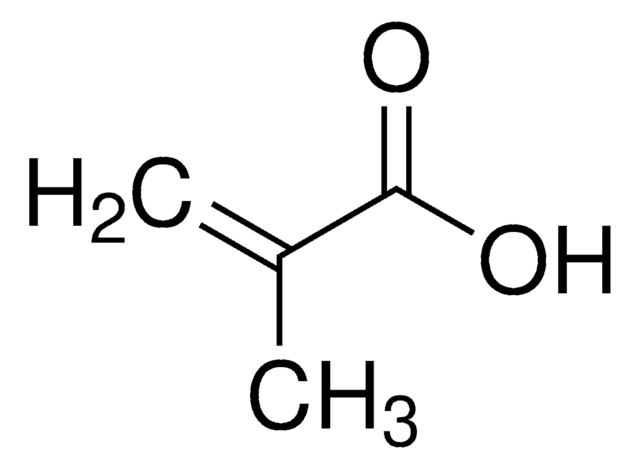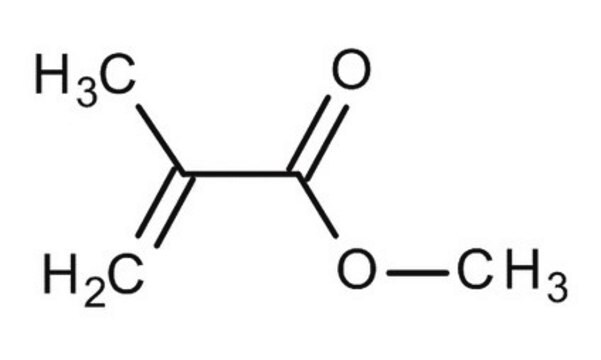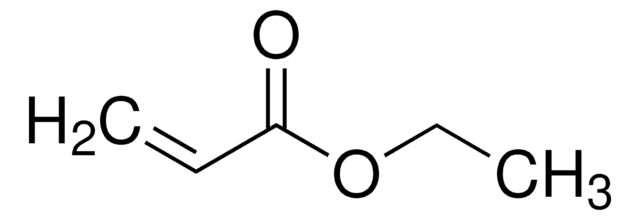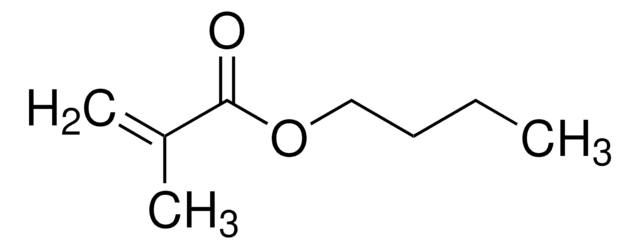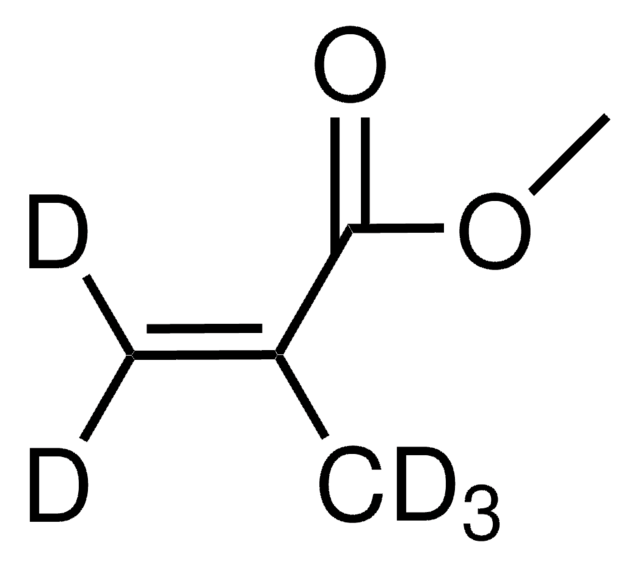M55909
Methylmethacrylat
contains ≤30 ppm MEHQ as inhibitor, 99%
Synonym(e):
Methacrylsäuremethylester, Methyl-2-methylprop-2-enoat
About This Item
Empfohlene Produkte
Dampfdichte
3.5 (vs air)
Qualitätsniveau
Dampfdruck
29 mmHg ( 20 °C)
Assay
99%
Selbstzündungstemp.
815 °F
Enthält
≤30 ppm MEHQ as inhibitor
Expl.-Gr.
12.5 %
Brechungsindex
n20/D 1.414 (lit.)
bp
100 °C (lit.)
mp (Schmelzpunkt)
−48 °C (lit.)
Dichte
0.936 g/mL at 25 °C (lit.)
Lagertemp.
2-8°C
SMILES String
COC(=O)C(C)=C
InChI
1S/C5H8O2/c1-4(2)5(6)7-3/h1H2,2-3H3
InChIKey
VVQNEPGJFQJSBK-UHFFFAOYSA-N
Suchen Sie nach ähnlichen Produkten? Aufrufen Leitfaden zum Produktvergleich
Allgemeine Beschreibung
Anwendung
- Mit einem Lanthanidkomplex veredeltes Poly(methylmethacrylat-co-maleinsäureanhydrid)-Copolymer. Diese lumineszierenden Polymere weisen eine hohe thermische Stabilität auf und können als leuchtende Schichten für optoelektronische Geräte verwendet werden.
- Poly(methylmethacrylat) (PMMA) ist ein gängiges Material, das bei der Herstellung von Linsen zur Konzentrierung von Photovoltaikmodulen (CPV) verwendet wird.
- Polymethylmethacrylat, Methylmethacrylat-Crosspolymer und Methylmethacrylat/Glykoldimethacrylat-Cosspolymere. Diese Polymere werden in der kosmetischen Chirurgie, Zahnmedizin und beim Gelenkersatz verwendet.
- Auf Poly(methylmethacrylat) (PMMA) basierende maßgeschneiderte Medizinprodukte.
- Interpenetrierenden polymeren Netzwerken auf Methylmethacrylatbasis mit verbesserten thermischen und mechanischen Eigenschaften.
- Poly(methylmethacrylat-co-hydroxyethylmethacrylat)-Copolymere (PMMA-co-PHEMA) durch Emulsionscopolymerisation. Diese Copolymere bilden thermooxidativ stabile und duktile Folien.
- Poly(methylmethacrylat)-Nanopartikel durch differentielle Mikroemulsion-Polymerisation.
Signalwort
Danger
H-Sätze
Gefahreneinstufungen
Flam. Liq. 2 - Skin Irrit. 2 - Skin Sens. 1B - STOT SE 3
Zielorgane
Respiratory system
Lagerklassenschlüssel
3 - Flammable liquids
WGK
WGK 1
Flammpunkt (°F)
50.0 °F - closed cup
Flammpunkt (°C)
10 °C - closed cup
Persönliche Schutzausrüstung
Eyeshields, Faceshields, Gloves, type ABEK (EN14387) respirator filter
Hier finden Sie alle aktuellen Versionen:
Besitzen Sie dieses Produkt bereits?
In der Dokumentenbibliothek finden Sie die Dokumentation zu den Produkten, die Sie kürzlich erworben haben.
Kunden haben sich ebenfalls angesehen
Artikel
RAFT (Reversible Addition Fragmentation chain Transfer) polymerization is a reversible deactivation radical polymerization (RDRP) and one of the more versatile methods for providing living characteristics to radical polymerization.
The manufacture of monomers for use in ophthalmic applications is driven by the need for higher purity, improved reliability of manufacturing supply, but ultimately by the need for the increased comfort, convenience, and safety of contact lens wearers. Daily wear contact lenses have the potential to fill this need for many customers; however, their widespread use is constrained by higher costs compared to weekly- or monthly-based lenses. New approaches that improve cost structure and result in higher quality raw materials are needed to help make contact lenses more affordable and accelerate growth of the contact lens market.
Protokolle
We presents an article about ARGET ATRP, and its procedure for PMMA polymer brush growth. Surface preparation before polymer brush growth consists of two steps: surface cleaning and initiator monolayer deposition.
Unser Team von Wissenschaftlern verfügt über Erfahrung in allen Forschungsbereichen einschließlich Life Science, Materialwissenschaften, chemischer Synthese, Chromatographie, Analytik und vielen mehr..
Setzen Sie sich mit dem technischen Dienst in Verbindung.
